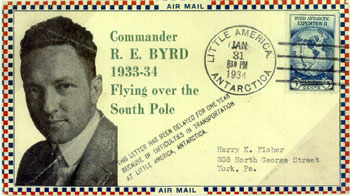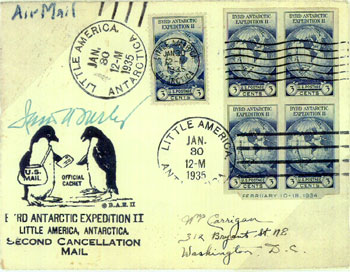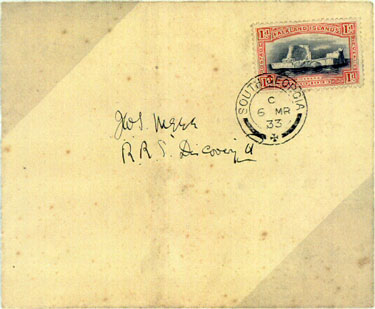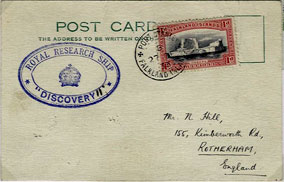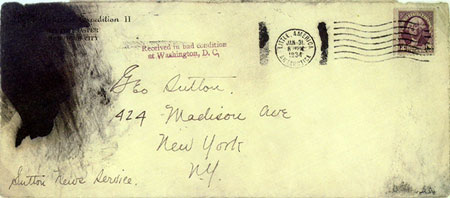 |
FIRST CANCELLATION MAIL A fee of 50¢ was charged for all covers serviced at Little America. About 54,000 pieces of mail were received by the mail clerk in the first year. Despite the rules about use of regular postage, some covers were processed. Cancellation problems were encountered by freezing gears and congealing ink. A postal specialist was sent to assist with the second year mail while the regular clerk finished the job with the wrong date and many covers indelibly ink-smeared. |
|
A "Second Cancellation" cachet identified mail accumulated in New Zealand for handling in 1935. The remainder of the 1934 mail was identified by a "DELAYED" cachet and the incorrect date of January 31. All mail was delivered to the San Francisco post office after closing the base. (Courtesy of George Hall) |
SECOND CANCELLATION MAIL
|
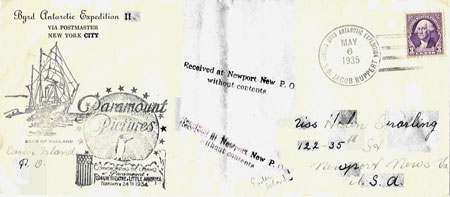 |
Mail from
a crewmember aboard the support ship SS JACOB RUPPERT,
canceled at the ship's authorized (Courtesy of Herb & Janice Harvis) |
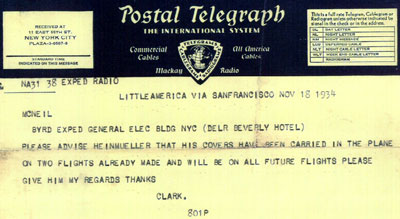
(Courtesy of the
George Hall)
Makintosh Oceanographic Surveys
1933-35
Discovery II Expedition
|
Scientist J.W.S. Marr, aboard the RRS DISCOVERY II during the Makintosh Oceanographic Surveys of 1933-35, addressed a cover to himself. This piece of mail was delivered back to him at the postal counter. Extensive work at sea limited mail from this expedition. (Courtesy of George Hall) |
The expedition made several long voyages through the Pacific and Atlantic sectors of the Southern Ocean, examining whale populations and their environment. The vessel visited Marion Island, South Georgia, South Orkney Islands and the South Shetlands, making surveys in the last group.
Port Stanley, Falkland Islands - canceled 27 December 1933. This England-bound mail was sent from a crewmember aboard the British Antarctic oceans research vessel RRS DISCOVERY II , as it was about to conduct its second Antarctic waters circumpolar research cruise. (Courtesy of Herb & Janice Harvis) |
Could It Be DISCOVERY II Mail ? . . .
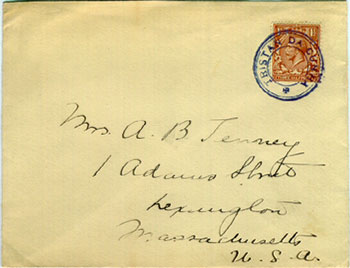 TRISTAN DA CUNHA TYPE V HANDSTAMP |
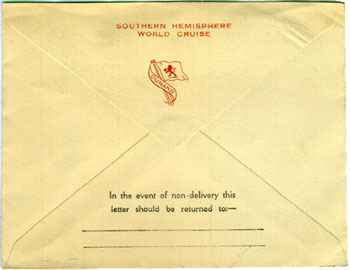 CUNARD'S WHITE STAR LINE WORLD CRUISE 1933 |
|
(Courtesy
of Gary Pierson)
|
|
|
Mail for Tristan da Cunha was piling up in the Simonstown post office in Cape Town, South Africa. On October 5, 1932, the postmaster wrote a letter to the Postmaster General inquiring as to whether or not this mail should be forwarded to London since no vessel had called to pick up and deliver Tristan's mail since HMS CARLISLE did so some 10 months earlier. This letter prompted inquiries within the London Post Office and Colonial Office which resulted in reaching an agreement with the Cunard Steamship Company to fit in a call at Tristan da Cunha by SS CORINTHIA while on its world cruise in 1933. The cruise left New York on January 7, 1933 and arrived back in New York on May 25 after visiting 37 different ports. But . . . the call at Tristan would only be possible if weather conditions permitted. If the weather was too extreme, mail for Tristan would be taken to South America and brought back to London at a later date. Usual notices were announced to the public concerning this special arrangement and a letter from Douglas Gane was published in The Times on February 24, 1933, appealing for donations and gifts for the islanders whose potato crop had once again failed. Imperial Airways, Ltd. came into the picture to support the mission. A Mr. Henderson of the Airways Terminus at Victoria Station London wrote a letter to the London Post Office on March 21 stating that a later time for posting would be available by using the "Air Service", which was scheduled to leave London for Cape Town on April 12. The Post Office agreed, but set the date back to April 5 in order to make connection in Cape Town with SS CORINTHIA. An official Post Office Notice was announced with the added statement that, "Correspondence may also be sent by the direct air service from Croydon to Cape Town for which the latest time of posting in the Air Mail box at the G.P.O. is 11:00 a.m. on Wednesday the 5th of April. The air charges are the same as for South Africa." This is the first reference to air mail in connection with Tristan da Cunha. The mail in London, all 58 bags weighing a ton-and-a-half, was finally sent out to Cape Town aboard SS ARMADALE CASTLE to connect with SS CORINTHIA. The transfer was made and SS CORINTHIA arrived off Tristan on April 27 but as luck would have it, the weather was too poor to offload the mail. As a result, the mail was dropped in Montivideo, Uruguay and transfered to SS ORANIA which took the mail to Rio de Janeiro. From Rio, the Japanese vessel MANILA MARU sailed across the Atlantic with Tristan's mail, failing to stop at Tristan for unknown reasons, and left the mail once again in Cape Town. It was July 1933, nine months having passed since the beginning of the attempted delivery! The Cape Town post office dreaded having to deal with all this mail again. The next vessel that could possibly stop at Tristan would be SS ATLANTIS on February 19, 1934, but that was 7 months away. However, in October 1933 the Colonial Office wrote a letter to the Postmaster General stating that RRS DISCOVERY II would be visiting Tristan in the course of its sailing from London to South Georgia Island later that month. The research ship offered to carry Tristan's mail and 3 tons of stores for the islanders. The London Post Office and Mr. Gane jumped at the opportunity and so, for the second time, Tristan's mail was on the move from Cape Town to London. The regular Cape Town boat WARWICK CASTLE delivered the mail to London, now having grown to a total of 63 bags! Of interest is a note attached to the bags which stated, "In addition to the above, 1 bag of Paquebot mail posted on the CARINTHIA and addressed to Mr. Robert Glass, Tristand da Cunha was received." There is no hint as to the size of this bag, but any size bag of mail addressed to one single person causes one to question the contents. It appears to be a mystery but one theory is that the bag contained philatelic mail. DISCOVERY II sailed with Tristan's mail from London on October 20, 1933. Mail was landed at Tristan on November 16, 1933. But . . . only 51 lbs. of mail was offloaded. Where was all the rest? The WARWICK CASTLE arrived in Southampton with the mail from Cape Town three days after the sailing of SS DISCOVERY II on her voyage south. The only remaining choice was to hold this mail and send it with SS ATLANTIS some three months down the road. Sailing on her 1934 Winter Cruise from Southampton on January 26, 1934, SS ATLANTIS arrived at Tristan and offloaded the last of the mail on February 19, 1934. It took 16 months to deliver the mail! Sailing with the SS ATLANTIS was the Rev. Harold Wilde who was coming out to relieve the Rev. Partridge. In Rev. Wilde's possession was the TYPE V handstamp used to cancel the cover illustrated above. |
British Naval Voyage
1934
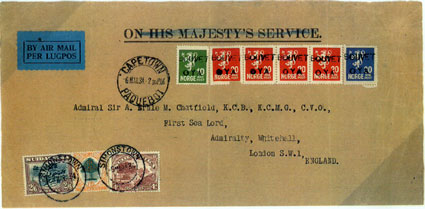 |
A visit by the HMS MILFORD to Bouvet Island in 1934 established a "first" when Admiral Evans overprinted a supply of Norwegian stamps to commemorate the visit. The Cape Town post office accepted the mail although the Norwegian authorities later refused to honor the actions of their Consul-General. The additional Cape Town stamps suggests the sender had some doubts about the letter passing through the mail. (Courtesy of George Hall) |
2nd Voyage of
the M/V Wyatt Earp
1934-35
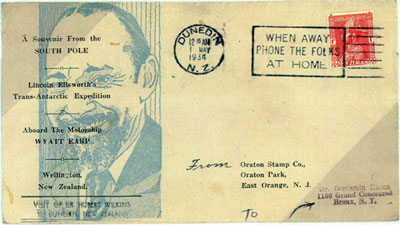 |
The M/V WYATT EARP carried Lincoln Ellsworth and his plane 48,000 miles in search of a suitable taking-off ground for a 20-hour flight across Antarctica. The plan to fly across the Antarctic continent from the Antarctic Peninsula to the Ross Sea was frustrated by continuous bad weather. A short flight along the east coast of Trinity Peninsula was made from Snow Hill Island to the Nordenskjöld Coast. Souvenir covers were mailed from New Zealand during the return from the Bay of Whales to repair damage to one of the airplane skis. The plane had to ultimately be taken to California for repairs. (Courtesy of George Hall) |
3rd Voyage of
the M/V Wyatt Earp
1935-36
|
Piloted by Herbert Hollick-Kenyon, Lincoln Ellsworth made the first Trans-Antarctic flight, from Dundee Island to the Bay of Whales, in November 1935. They reported the discovery of 'Eternity Range', naming it 'James W. Ellsworth Land (Ellsworth Land) and claimed it for the United States. Four landings were made during the crossing, however the plane came down twelve miles short of the abandoned base at Little America. The RRS DISCOVERY II was sent from Australia to the Ross Sea to find them after radio communications failed. They were picked up and four days later transferred to the M/V WYATT EARP. Mail from the DISCOVERY was dispatched in "Committee Pouches" and placed in the mail in England. (Courtesy of George Hall) |
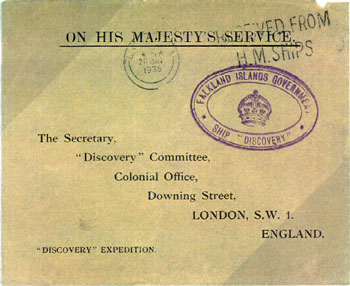 |
Ellsworth Antarctic
Expedition
1938-39
|
One of possibly only two known pieces of mail of its type from the post Trans-Antarctic flight expedition exploratory cruise of the M/V WYATT EARP by Sir Hubert Wilkins and Lincoln Ellsworth. The cover is over-affixed with Australian postage, canceled in Sydney and annotated in Wilkins handwriting. The cover was posted upon return of the ship after important new lands were discovered on the overflight. The cover has also been autographed by Lincoln Ellsworth. The recipient is the former Antarctic expedition pioneer and prominent polar philatelist, J. Harvey Pirie. The cover is stamped with rarely seen ship straight line marking. (Courtesy of Herb & Janice Harvis) |
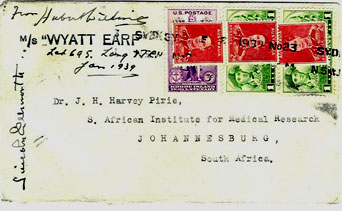 |
